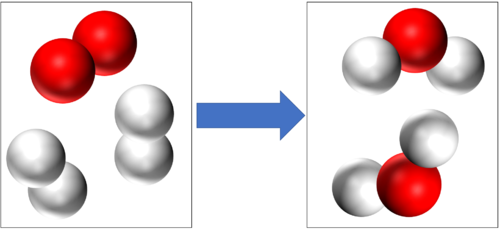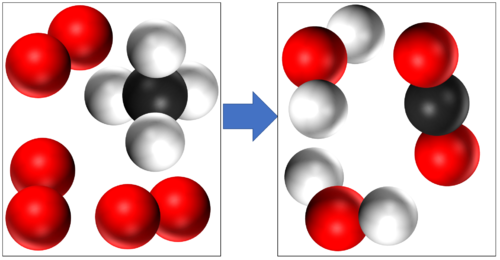Difference between revisions of "Conservation of Mass"
(→Calculating the Mass Required for a Complete Reaction) |
(→Calculating the Mass Required for a Complete Reaction) |
||
| Line 121: | Line 121: | ||
Find the [[Relative Formula Mass]] of the [[reactant]]s. | Find the [[Relative Formula Mass]] of the [[reactant]]s. | ||
| − | Mg = 24g | + | M<sub>r</sub> of Mg = 24g |
| − | O<sub>2</sub> = 16x2 | + | M<sub>r</sub> of O<sub>2</sub> = 16x2 |
| − | O<sub>2</sub> = 32g | + | M<sub>r</sub> of O<sub>2</sub> = 32g |
| style="height:20px; width:200px; text-align:center;" | | | style="height:20px; width:200px; text-align:center;" | | ||
| + | Find the [[Relative Formula Mass]] of the [[reactant]]s. | ||
| + | |||
| + | M<sub>r</sub> of CH<sub>4</sub> = 16g | ||
| + | |||
| + | M<sub>r</sub> of O<sub>2</sub> = 16x2 | ||
| + | |||
| + | M<sub>r</sub> of O<sub>2</sub> = 32g | ||
| style="height:20px; width:200px; text-align:center;" | | | style="height:20px; width:200px; text-align:center;" | | ||
| + | Find the [[Relative Formula Mass]] of the [[reactant]]s. | ||
| + | |||
| + | M<sub>r</sub> of NaOH = 40g | ||
| + | |||
| + | M<sub>r</sub> of HCl = 36.5g | ||
|- | |- | ||
| Line 135: | Line 147: | ||
State the [[ratio]] of [[mole]]s of each [[chemical]] needed. | State the [[ratio]] of [[mole]]s of each [[chemical]] needed. | ||
| − | 2 [[mole]]s of | + | 2 [[mole]]s of Mg are needed for every 1 [[mole]] of O<sub>2</sub> |
| style="height:20px; width:200px; text-align:center;" | | | style="height:20px; width:200px; text-align:center;" | | ||
| + | State the [[ratio]] of [[mole]]s of each [[chemical]] needed. | ||
| + | |||
| + | 1 [[mole]] of CH<sub>4</sub> is needed for every 2 [[mole]]s of O<sub>2</sub> | ||
| + | |||
| style="height:20px; width:200px; text-align:center;" | | | style="height:20px; width:200px; text-align:center;" | | ||
| + | State the [[ratio]] of [[mole]]s of each [[chemical]] needed. | ||
| + | |||
| + | 1 [[mole]] of HCl are needed for every 1 [[mole]] of NaOH | ||
| + | |||
|- | |- | ||
| + | |||
| style="height:20px; width:200px; text-align:center;" | | | style="height:20px; width:200px; text-align:center;" | | ||
Find the number of [[mole]]s supplied of the known [[mass]]. | Find the number of [[mole]]s supplied of the known [[mass]]. | ||
| Line 149: | Line 170: | ||
No. [[Mole]]s = 2 Mole | No. [[Mole]]s = 2 Mole | ||
| − | Therefore 1 [[mole]] of O<sub>2</sub> needed. | + | Therefore 1 [[mole]] of O<sub>2</sub> is needed. |
1 [[mole]] of O<sub>2</sub> = 32g | 1 [[mole]] of O<sub>2</sub> = 32g | ||
| style="height:20px; width:200px; text-align:center;" | | | style="height:20px; width:200px; text-align:center;" | | ||
| + | Find the number of [[mole]]s supplied of the known [[mass]]. | ||
| + | |||
| + | No. [[Mole]]s = <math>\frac{Mass}{M_r}</math> | ||
| + | |||
| + | No. [[Mole]]s = <math>\frac{32}{16}</math> | ||
| + | |||
| + | No. [[Mole]]s = 2 Mole | ||
| + | |||
| + | Therefore 4 [[mole]]s of O<sub>2</sub> are needed. | ||
| + | |||
| + | 4 [[mole]]s of O<sub>2</sub> = 128g | ||
| + | |||
| style="height:20px; width:200px; text-align:center;" | | | style="height:20px; width:200px; text-align:center;" | | ||
| + | Find the number of [[mole]]s supplied of the known [[mass]]. | ||
| + | |||
| + | No. [[Mole]]s = <math>\frac{Mass}{M_r}</math> | ||
| + | |||
| + | No. [[Mole]]s = <math>\frac{20}{40}</math> | ||
| + | |||
| + | No. [[Mole]]s = 0.5 Mole | ||
| + | |||
| + | Therefore 0.5 [[mole]] of HCl is needed. | ||
| + | |||
| + | 0.5 [[mole]] of HCl = 18.25g | ||
| + | |||
|} | |} | ||
Revision as of 13:35, 3 January 2019
Contents
Key Stage 3
Meaning
Conservation of Mass is a law of the universe that states that mass cannot be created or destroyed, it can only be moved from one place to another.
About Conservation of Mass
- In dissolving conservation of mass means that the mass of the solvent and the mass of the solute can be added to find the mass of the solution.
| Masssolvent + Masssolute = Masssolution |
- In a chemical reaction conservation of mass means that the same atoms which made up the reactants must make up the products. So the atoms are not created or destroyed in a chemical reaction, they are just rearranged.
|
Conservation of mass tells us that if there are 4 Hydrogen atoms and 2 Oxygen atoms at the start of this reaction then there will be the end of the reaction 4 Hydrogen atoms and 2 Oxygen atoms at the end of the reaction. |
|
In this reaction you can see that mass is conserved because there are 4 Hydrogen atoms, 4 Oxygen atoms and 1 Carbon atom in the reactants and all the same atoms are found in the products. |
Key Stage 4
Meaning
Conservation of Mass is a law of the universe that states that mass cannot be created or destroyed, it can only be moved from one place to another.
About Conservation of Mass
- In a chemical reaction law of conservation of mass indicates that the total mass of the products is the same as the total mass of the reactants.
Examples
Methane + Oxygen → Water + Carbon Dioxide
CH4 + 2O2 → 2H2O + CO2
16g + 64g = 36g + 44g
Sodium Hydroxide + Hydrochloric Acid → Sodium Chloride + Water
NaOH + HCl → NaCl + H2O
40g + 36.5g = 58.5 + 18g
Calculating the Mass of a missing Product/Reactant
- The mass of a missing product of reactant can be found because the total mass of the products = the total mass of reactants.
MReactants = MProducts
|
Find the mass of Calcium Oxide produced in the following reaction: CaCO3 → CaO + CO2 25g = x + 11g |
Find the mass of Carbon Dioxide produced in the following reaction: CH4 + 2O2 → 2H2O + CO2 4g + 16g = 9g + x |
Find the mass of Hydrochloric Acid needed in the following reaction: NaOH + HCl → NaCl + H2O 160g + x = 234g + 72g |
|
x = 25g - 11g x = 14g |
20g = 9g + x x = 20g - 9g x = 11g |
160g + x = 306g x = 306g - 160g x = 146g |
Calculating the Mass Required for a Complete Reaction
|
Find the mass of Oxygen needed to completely oxidise all of the Magnesium: 2Mg + O2 → 2MgO 48g + x = y |
Find the mass of Oxygen needed for the complete combustion of Methane. CH4 + 2O2 → 2H2O + CO2 32g + x = y |
Find the mass of Hydrochloric Acid needed to completely neutralise all of the Sodium Hydroxide. NaOH + HCl → NaCl + H2O 20g + x = y + z |
|
Find the Relative Formula Mass of the reactants. Mr of Mg = 24g Mr of O2 = 16x2 Mr of O2 = 32g |
Find the Relative Formula Mass of the reactants. Mr of CH4 = 16g Mr of O2 = 16x2 Mr of O2 = 32g |
Find the Relative Formula Mass of the reactants. Mr of NaOH = 40g Mr of HCl = 36.5g |
|
Find the number of moles supplied of the known mass. No. Moles = \(\frac{Mass}{M_r}\) No. Moles = \(\frac{48}{24}\) No. Moles = 2 Mole Therefore 1 mole of O2 is needed. 1 mole of O2 = 32g |
Find the number of moles supplied of the known mass. No. Moles = \(\frac{Mass}{M_r}\) No. Moles = \(\frac{32}{16}\) No. Moles = 2 Mole Therefore 4 moles of O2 are needed. 4 moles of O2 = 128g |
Find the number of moles supplied of the known mass. No. Moles = \(\frac{Mass}{M_r}\) No. Moles = \(\frac{20}{40}\) No. Moles = 0.5 Mole Therefore 0.5 mole of HCl is needed. 0.5 mole of HCl = 18.25g |


